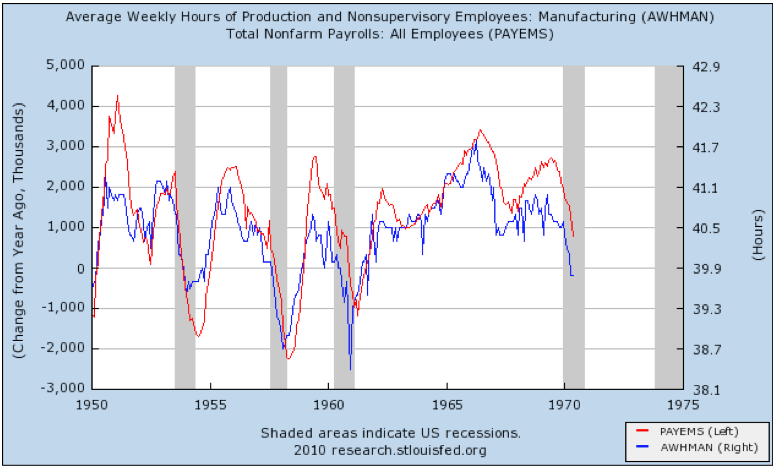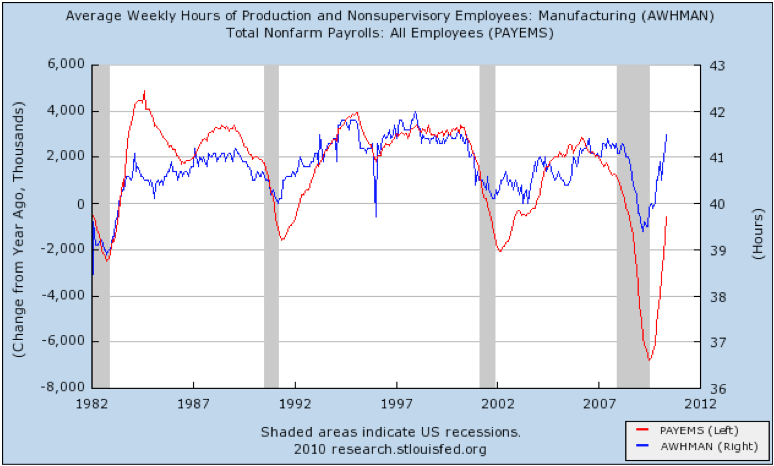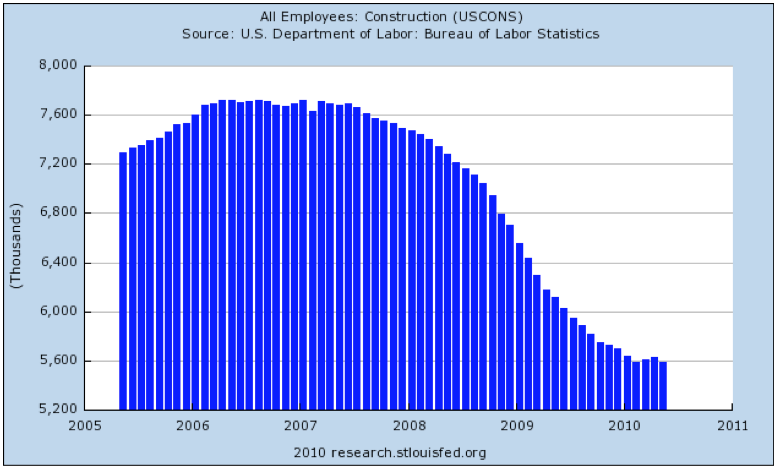Here we are at Jobs Week again, with June nonfarm payrolls to be reported on Friday. As I noted at the end of last week, while the housing market, a big long leading indicator, is of great concern, payrolls are a coincident indicator, and I wouldn't expect them to turn simultaneously with leading indicators (although deflationary busts can come on quickly).
One short leading indicator for payrolls is average hours worked in manufacturing. It hasn't gotten the attention it has deserved, but as we will see, it has been on a tear, coming in at 41.5 hours in May.
How good a reading is that? Well, let's look at the last 60 years. Here is average hours worked in manufacturing (blue), with year over year change in payrolls (red), since 1950:

But notice the job situation as well. On each of those occasions, manufacturing hours over 41.0 coincided or led by between 1 and 9 months, annual job growth of at least 2 million. Here's the actual data:
Notice that manufacturing hours were above 41.0 only a few times in the 1950s, and blew through to 42.0 hours at the peak of the housing boom.
1950 0 months
1952 9 months
1955 2 months
1955 0 months
1964 1 month
1969 0 months
1952 9 months
1955 2 months
1955 0 months
1964 1 month
1969 0 months
I haven't included the 1970s, because they stunk. At no point did factory hours worked meet or exceed 41.0 hours.

Now let's turn to the 1980s through the present.

Notice again that factory hours only meaningfully exceed 41.0 in the latter part of the 1980s, during much of the 1990s, and at the peak of the housing boom -- and now. In fact, the only time during this period that manufacturing hours were as high as 41.5 was as the "jobless recovery" of the early 1990s finally gave way to real growth, and during the tech boom.
Once again, during this time a reading over 41.0 for at least two months (note that in 1992, there was only one month in which factory hours just equalled 41.0 hours) coincided with or led annual job growth of 2 million jobs by 0 to 8 months. Again, here is the actual data:
1987 0 months
1992 n/a (one months 0f 41.0 only)
1993 5 months
2004 8 months
2005 0 months
1993 5 months
2004 8 months
2005 0 months
Note, however, that manufacturing hours stayed strong right into 2008, while payrolls declined from +2 million jobs annually, to an actual loss year-over-year by the time manufacturing declined. It was only when the housing bust metasticised from construction and Wall Street into the general economy in late 2008 that manufacturing hours went down.
So, despite the strength in manufacturing -- strength which has only been equalled a few times in the post WW2 era -- mean a short return to 2 million jobs year over year, or will construction again make this an exception? Well, let's take a look at that collapse in construction jobs:

Over 2 million construction jobs -- more than 25% of the total -- have been lost since the housing bust began. On average about 50,000 construction jobs a month were lost from 2007 through 2009. Notice, however, that they have stabilized this year so far. (Note: construction jobs aren't broken down between commercial and residential in the statistics).
It certainly seems likely that there will be at least another brief spasm downward in construction jobs, given the stark decline in housing permits and starts, but probably nothing like the last few years.
In other words, while we may not hit 2 million plus jobs created year over year by the end of this year, it certainly looks like there is enough upward momentum to sustain job creation for at least a few more months, even if leading indicators have become at least temporarily more foreboding.